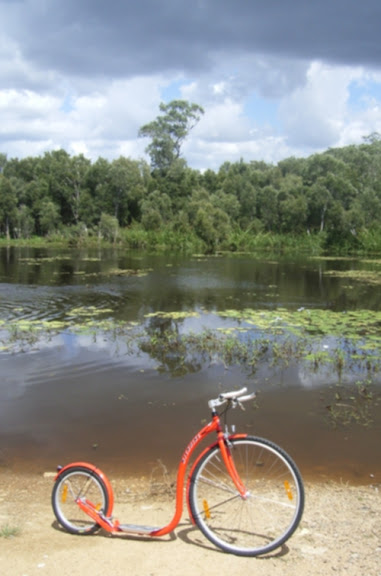
The main game is to head off as many mornings as I can in a north eastery direction. Down my suburban street, across the Cannery Creek foot bridge; past the Golden Circle ("pineapple")Cannery; climb the Banyo Hill; pass the high school and Catholic University; along the cemetery to the Nudgee Waterholes.
Voila!
There I dismount; cast a weathered eye across the water to note the water lilly blooms and water birds; check to see if the turtles are rushing up to me --as they inevitably do -- do a circuit of the lake by circumventing the bora ring*
 Is this a special place? For me the whole area is where I live. Its geography ecology and urbanology; its history and pre-history. I work at being informed and appreciate the consequences of it being a swamp.
Is this a special place? For me the whole area is where I live. Its geography ecology and urbanology; its history and pre-history. I work at being informed and appreciate the consequences of it being a swamp.So now, with my kickbike I get to range wider than my daily walks had enabled me. So each day now I can commune with the Nudgee Water Holes: a perennial pond fed from a spring which rises in the cemetery in the slope above it. Fed by the rotting corpses of dead white people -- the waterholes and its bora rings were a major ceremonial site of the Turrubul people in the "Brisbane" district up until 1860 when the last corroboree was held here.
The ring intersected with a major pathway which led to the Bunya Mountains where mass gatherings of indigenous groupings were held to coincide with the bunya nut ripenings in the Bunya Mountains(image below) -- on the Great Dividing Range.
The first whites traversed this area in 1823 -- three lost (and rather stupid) ex convicts who had been "ship" wrecked and lost on one of the Moreton bay Islands.
They made an excursion to the north (Thinking they could make it to Sydney that way! --DR), but Pamphlet and Finnegan each returned to Point Skirmish; Parsons was last seen by Finnegan in the vicinity of Noosa. Pamphlet and Finnegan were found at Point Skirmish by John Oxley on 29 and 30 November, respectively.SourceJohn Finnegan, Thomas Pamphlet and Richard Parsons were sailing from Sydney to Illawarra(!) to take on a cargo of timber when they were blown off course by a gale. Eventually they were shipwrecked on Moreton Island on 15 April 1823. They walked north along the beach to Cape Moreton, then continued along the northern shore and down the western side of the island to the South Passage. They crossed the South Passage by native canoe, and found the natives at Amity Point most hospitable. Eventually they built a canoe of their own, in which they crossed to Peel Island and then to the mainland near Cleveland. They followed the Brisbane River upstream as far as Oxley Creek on foot. They reached Redcliffe (NB:north of the current waterholes site--DR)on 30 June, and by late September were at Pumicestone Channel near Point Skirmish (Bribie Island), enjoying the patronage of the local people.
And among it all is me on a kickbike.
*A Bora is the name given both to an initiation ceremony of Indigenous Australians, and to the site on which the initiation is performed. At such a site, young boys are transformed into men. The initiation ceremony differs from culture to culture, but often involves circumcision and scarification, and may also involve the removal of a tooth or part of a finger. The ceremony, and the process leading up to it, involves the learning of sacred songs, stories, dances, and traditional lore. Many different clans will assemble to participate in an initiation ceremony.
Bora rings, found in South-East Australia, are circles of foot-hardened earth surrounded by raised embankments. They were generally constructed in pairs (although some sites have three), with a bigger circle about 22 metres in diameter and a smaller one of about 14 metres. The rings are joined by a sacred walkway.
